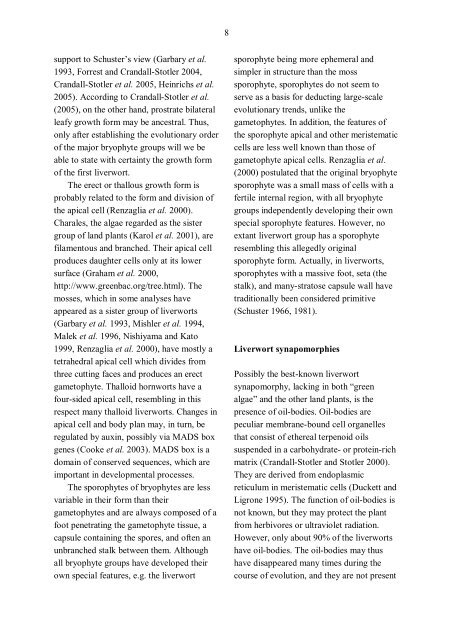Evolutionary relationships of liverworts with a special focus ... - Doria
Evolutionary relationships of liverworts with a special focus ... - Doria
Evolutionary relationships of liverworts with a special focus ... - Doria
You also want an ePaper? Increase the reach of your titles
YUMPU automatically turns print PDFs into web optimized ePapers that Google loves.
8<br />
support to Schuster’s view (Garbary et al.<br />
1993, Forrest and Crandall-Stotler 2004,<br />
Crandall-Stotler et al. 2005, Heinrichs et al.<br />
2005). According to Crandall-Stotler et al.<br />
(2005), on the other hand, prostrate bilateral<br />
leafy growth form may be ancestral. Thus,<br />
only after establishing the evolutionary order<br />
<strong>of</strong> the major bryophyte groups will we be<br />
able to state <strong>with</strong> certainty the growth form<br />
<strong>of</strong> the first liverwort.<br />
The erect or thallous growth form is<br />
probably related to the form and division <strong>of</strong><br />
the apical cell (Renzaglia et al. 2000).<br />
Charales, the algae regarded as the sister<br />
group <strong>of</strong> land plants (Karol et al. 2001), are<br />
filamentous and branched. Their apical cell<br />
produces daughter cells only at its lower<br />
surface (Graham et al. 2000,<br />
http://www.greenbac.org/tree.html). The<br />
mosses, which in some analyses have<br />
appeared as a sister group <strong>of</strong> <strong>liverworts</strong><br />
(Garbary et al. 1993, Mishler et al. 1994,<br />
Malek et al. 1996, Nishiyama and Kato<br />
1999, Renzaglia et al. 2000), have mostly a<br />
tetrahedral apical cell which divides from<br />
three cutting faces and produces an erect<br />
gametophyte. Thalloid hornworts have a<br />
four-sided apical cell, resembling in this<br />
respect many thalloid <strong>liverworts</strong>. Changes in<br />
apical cell and body plan may, in turn, be<br />
regulated by auxin, possibly via MADS box<br />
genes (Cooke et al. 2003). MADS box is a<br />
domain <strong>of</strong> conserved sequences, which are<br />
important in developmental processes.<br />
The sporophytes <strong>of</strong> bryophytes are less<br />
variable in their form than their<br />
gametophytes and are always composed <strong>of</strong> a<br />
foot penetrating the gametophyte tissue, a<br />
capsule containing the spores, and <strong>of</strong>ten an<br />
unbranched stalk between them. Although<br />
all bryophyte groups have developed their<br />
own <strong>special</strong> features, e.g. the liverwort<br />
sporophyte being more ephemeral and<br />
simpler in structure than the moss<br />
sporophyte, sporophytes do not seem to<br />
serve as a basis for deducting large-scale<br />
evolutionary trends, unlike the<br />
gametophytes. In addition, the features <strong>of</strong><br />
the sporophyte apical and other meristematic<br />
cells are less well known than those <strong>of</strong><br />
gametophyte apical cells. Renzaglia et al.<br />
(2000) postulated that the original bryophyte<br />
sporophyte was a small mass <strong>of</strong> cells <strong>with</strong> a<br />
fertile internal region, <strong>with</strong> all bryophyte<br />
groups independently developing their own<br />
<strong>special</strong> sporophyte features. However, no<br />
extant liverwort group has a sporophyte<br />
resembling this allegedly original<br />
sporophyte form. Actually, in <strong>liverworts</strong>,<br />
sporophytes <strong>with</strong> a massive foot, seta (the<br />
stalk), and many-stratose capsule wall have<br />
traditionally been considered primitive<br />
(Schuster 1966, 1981).<br />
Liverwort synapomorphies<br />
Possibly the best-known liverwort<br />
synapomorphy, lacking in both “green<br />
algae” and the other land plants, is the<br />
presence <strong>of</strong> oil-bodies. Oil-bodies are<br />
peculiar membrane-bound cell organelles<br />
that consist <strong>of</strong> ethereal terpenoid oils<br />
suspended in a carbohydrate- or protein-rich<br />
matrix (Crandall-Stotler and Stotler 2000).<br />
They are derived from endoplasmic<br />
reticulum in meristematic cells (Duckett and<br />
Ligrone 1995). The function <strong>of</strong> oil-bodies is<br />
not known, but they may protect the plant<br />
from herbivores or ultraviolet radiation.<br />
However, only about 90% <strong>of</strong> the <strong>liverworts</strong><br />
have oil-bodies. The oil-bodies may thus<br />
have disappeared many times during the<br />
course <strong>of</strong> evolution, and they are not present
















